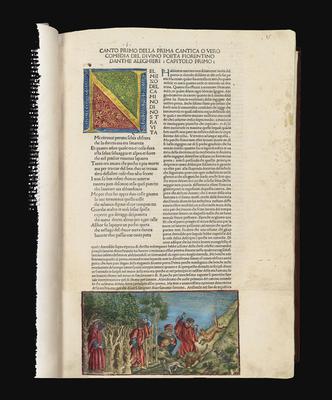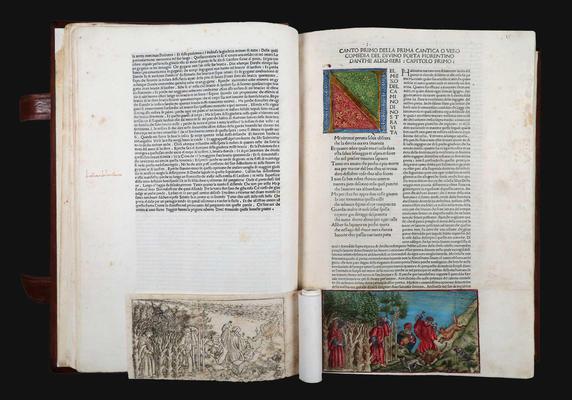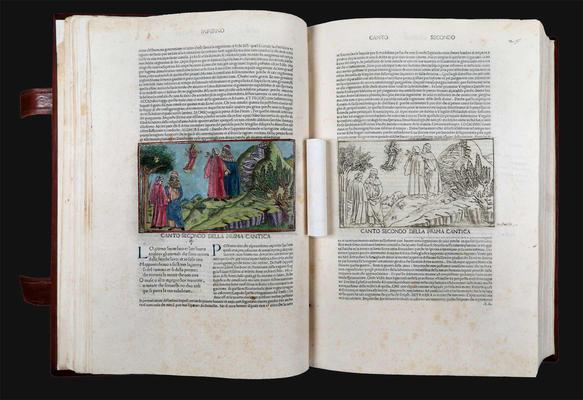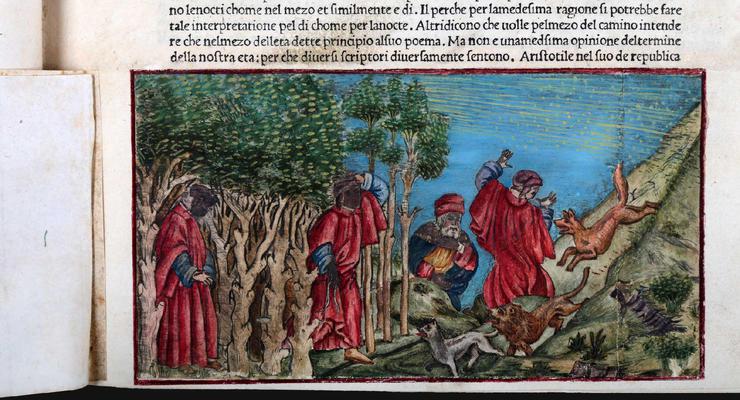Dante Alighieri
Comento di Cristophoro Landino Fiorentino sopra la Comedia di Danthe Alighieri poeta Fiorentino.
Florence, Nicolaus Laurentii, Alamanus, 30 August 1481.Folio (391x265 mm). Collation: (i-iii)8, [*]6, a10, b8, c-e10, f8, g10, h-i8, l10, m-n8, o-r10, s6, aa-gg10, hh12, ll-mm10, oo6, A8, B-H10, I6, L12. 368 of [372] leaves, wanting four blank leaves (fols. (i-iii)1, [*]6, a1, aa1). Text in one column, 45-48 lines, surrounded by commentary, 57-60 lines. Type: 4:114R (text), 5:91R (commentary). Early inked foliation in the upper right corner. On fol. a1r large illuminated initial in gold on blue, green and red ground, decorated with fine floral motifs in gold and white. Initials supplied in blue. On fols. a1r and b1v two copper engravings with contemporary colouring, with the same vignettes in their original uncoloured form tipped in alongside. Hazel calf binding in antique style, blind tooled, two metal clasps. An excellent copy. The lower margin of fol. a1r restored; small repair in the lower portion of fol. a8. Light foxing and finger-marks, occasional pale waterstains. Notes and marginal marks in different early hands. On fols. L10v and L11r vernacular poems in a sixteenth-century hand, including a sonnet by Coluccio Salutati (1331-1406) against Gian Galeazzo Visconti, and the reply in favour of the Visconti composed by Antonio Loschi (1365-1441). A loose leaf is inserted, with on its recto the first 78 verses of the Inferno, in two columns, copied in a fifteenth-century hand.
Provenance: Florence, the Camaldolese monastery of San Benedetto a Porta Pinti (sixteenth-century ownership inscription on the verso of the last leaf, ‘Questo libro e dello monastero di Sancto Benedetto. sito fuori della porta appi[n]ti della cipta [sic] di Firenze. dell[']ordine delle e[re]mo di camaldoli. sotto la regola di sancto Benedetto. Chi lla in prestanza lo re[n]da e guardilo daffanciugli, e da lucerna'); Marchese Francesco Maria Riccardi del Vernaccia (b. 1794; ex-libris on the front pastedown); Gustavo Camillo Galletti (1805-1868; stamp on the recto of the first leaf); Baron Horace de Landau (1824-1903; ex-libris on the front pastedown; Catalogue des livres manuscrits et imprimés composant la bibliothèque de M. Horace de Landau. Première partie, Florence 1885, p.156); Livio Ambrogio collection.
The first Florentine edition of the Commedia, the first to be illustrated – with engravings after the magnificent drawings by Sandro Botticelli – and the first appearance of Cristoforo Landino's Comento, the first vernacular commentary on the entire poem, the most authoritative achievement of fifteenth-century Dante scholarship.What makes the 1481 Dante a milestone in the history of the printed book is the series of engravings designed to provide a coherent figurative commentary to each of the cantos in the poem. Blank spaces are left throughout the volume for this purpose (except inPurgatorio, Cantosxivandxxv, and Paradiso, Cantoxxx), but only nineteen scenes in theInferno are known to have been completed. Almost all copies of the 1481 Commedia contain the first two engravings only, attributed to the Florentine engraver Baccio Baldini, a pupil of Maso Finiguerra. They are printed directly onto the page of text, at the beginning of the first two cantos. Only a very few copies include the complete series of nineteen engravings, printed – with the exception of the first two plates – on separate sheets, and later pasted into the volumes, as a result of the difficulties in printing the engravings exactly in the spaces left blank on purpose by the compositor. This edition was one of the last attempts in Italy to use copper engravings as illustrations for a long time.This copy includes an exceptional and possibly unique feature, containing the first two engravings coloured by a contemporary hand, and the same vignettes in their original uncoloured form tipped in alongside.





